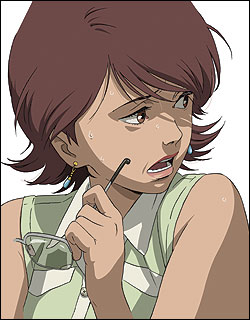Imagine—and this is going to take some imagining—that an American TV producer called in Charlie Kaufman and Spike Jonze and said to them: “Loved Adaptation; looooved Being John Malkovich! How about doing me a 13-part weekly half-hour series? Subject, style, approach, that’s all up to you. Push the envelope, get out there, astonish me. All I ask is: Give me something that will have people saying, ‘What the hell was that?’ and itching to tune in again next week to be blown away again.”
A little hard to imagine, right? But it happened—only in Japan. Back in 1997, Masao Maruyama, head of the edgy TV animation studio Mad House, gave a cartoon artist named Satoshi Kon a shot at directing a full-length animated film called Perfect Blue. A Disney or Dreamworks production it was not. Set on the seedy side of the world of Tokyo pop, Perfect Blue‘s story line featured psychosis, bloody murder, and soft-core porn. And it was a huge hit, while bringing Japanese animation, too long fodder for the fantasy lives of pubescent teens, onto the gritty streets of urban Japan today.
With two more successful feature-length animated films under his belt (2001’s Millennium Actress and 2003’s Tokyo Godfathers), Kon had little incentive to go back to work in the underfunded production-on-the-cheap TV anime factory. He took the project on primarily because he found he had too many ideas fighting for expression to save them up for the two or three years it takes to produce a feature anime. Paranoia Agent (Fridays, Cartoon Network) let him catch up. Its 13 episodes are exploding with ideas and images tumbling over one another in a breakneck-paced plot partaking equally of crime thriller and psycho-horror freakout.
Paranoia Agent begins with Japan experiencing one of its periodic media madnesses. Suddenly everybody from little kids to Grandpa discover that a big-eyed pink-and-black plush puppy named Maromi is the cutest thing on earth, thereby turning its shy, young-adult creator into a national celebrity. But the cameras are barely focused on her when she’s attacked (she says) by a snaggletoothed baseball-capped kid wearing in-line skates and wielding a bent aluminum baseball bat.
The police find her story a little hard to believe, but soon, “Shonen-Bato” strikes again and again. Now the attacker has become the celebrity, the people he attacks of secondary interest. An arrest is made, but the attacks go on. Do the police have the real Shonen-Bato or a wanna-be, or are they completely at sea? Is there a connection between the people victimized— a schoolboy, his tutor living a double life, her sleazy friend? Wider and wider spread the ripples. Soon, nobody’s talking or thinking of anything else.
Time Asia described Paranoia Agent as “a kind of Twin Peaks for Japanese animation,” but unlike David Lynch’s lugubriously paced and aimless series, Paranoia Agent is fast, tight, and knows exactly where it’s going, while keeping the viewer agreeably mystified to the very end. And unlike most of even high-end TV, it’s about something—the jittering, chattering, echoing mediasphere in which we spend most of our waking lives today.
A DVD of the series is available, but the only way you can currently see the show on the medium it was created for is on the late-night “Adult Swim” feature of the Cartoon Network. But keep your eyes open. Sooner or later F/X, Fox, or MTV has to wake up to it, or HBO or Showtime will realize they’re missing out. Paranoia Agent is too special, too vital, too damn entertaining to be stuck forever in fanboy limbo.
The four-DVD boxed set of Paranoia Agent is now available at Scarecrow Video and other Seattle video outlets for around $100.








